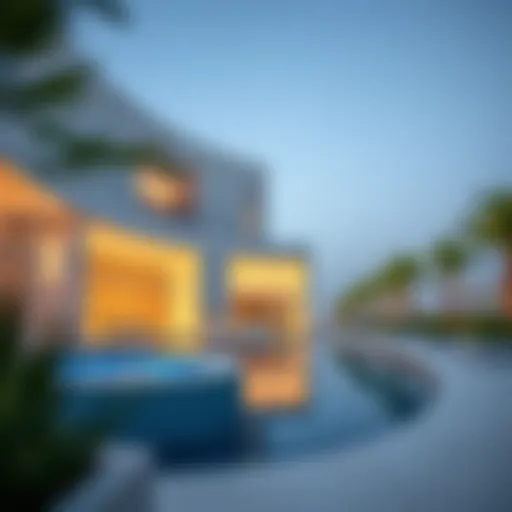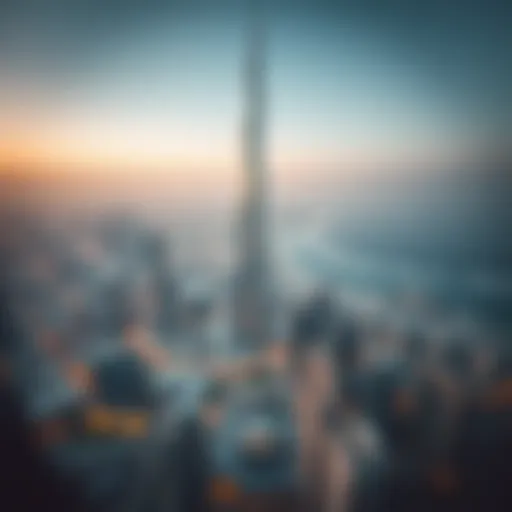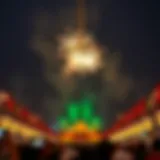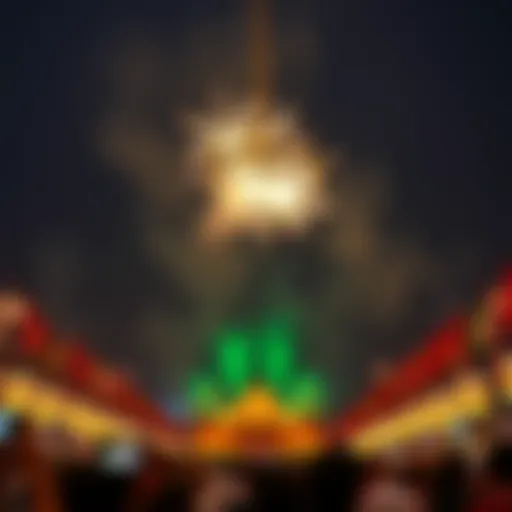Eid Al-Fitr 2023 in the UAE: Traditions and Impact
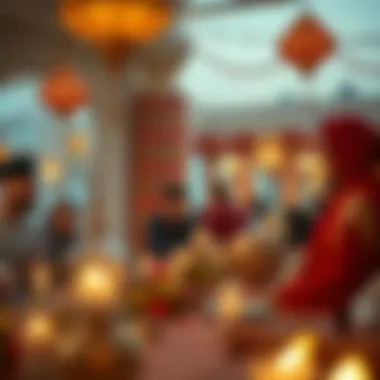

Intro
Eid Al-Fitr is one of the most significant Islamic holidays, celebrated with gusto and warmth across the globe. In the UAE, this occasion is a vibrant tapestry woven with both age-old traditions and modern elements, reflecting the nation’s unique cultural landscape. As Ramadan draws to a close, communities unite in a spirit of compassion, generosity, and joy, marking the end of fasting with a plethora of festivities.
The significance of Eid Al-Fitr in the UAE goes beyond mere celebration; it engages with social customs, economic activities, and community solidarity. Families gather, mosques fill with prayers, and a palpable sense of gratitude permeates the air. Festivities often include culinary delights, charitable giving, and cultural performances, creating a multi-faceted experience that attracts locals and tourists alike.
Yet, the impact of Eid Al-Fitr stretches into various sectors, notably the real estate market. The influx of visitors, gift-giving traditions, and the festive spirit stimulate economic activity, influencing property trends and investment opportunities. As the UAE navigates through the complexities of a globalized society, the integration of traditional practices with modernity becomes evident, making Eid not just a holiday, but a catalyst for growth and community connection.
Understanding Eid Al-Fitr
Understanding Eid Al-Fitr is crucial for grasping the cultural and social fabric of the UAE, particularly since it marks the end of Ramadan, a holy month of fasting and reflection. This celebration, observed by millions worldwide, plays an important role in the lives of individuals, families, and communities in the UAE. It is not just a religious event; it is a significant occasion that strengthens communal bonds, fosters generosity, and showcases the vibrant cultural diversity of the region.
Historical Relevance
Eid Al-Fitr, which literally translates to "Festival of Breaking the Fast," has deep historical roots. It dates back to the time of Prophet Muhammad in the 7th century. The first Eid was celebrated as a means of expressing gratitude to Allah for the strength and patience shown during the month-long fast of Ramadan. This historical context adds layers to the celebration—it's not just about joyful gatherings and feasting; it's about remembering a pivotal moment in Islamic history.
The occasion is marked by community prayers, a practice that has endured for centuries. People gather outside mosques, and in parks, often exceeding the confines of traditional prayer spaces. The communal aspect of these gatherings reflects a core value in Islamic teaching; unity and togetherness have always been celebrated elements of Eid.
Religious Significance
From a religious standpoint, Eid Al-Fitr holds immense significance. It's seen as a day of thanksgiving to Allah for the strength granted during Ramadan. Believers take part in a special prayer called the Salat al-Eid at sunrise. This prayer serves as a reminder of faith and community.
Furthermore, this day is observed as a time for Zakat al-Fitr, a form of charity that individuals are encouraged to give before the day begins. It ensures those in need can also partake in the celebrations. Thus, the act of giving becomes intertwined with the essence of the festival, highlighting compassion and community support, tenets central to the Islamic faith.
Cultural Variations
Cultural variations of Eid Al-Fitr can be seen in how different communities, including expatriate communities in the UAE, observe this significant day. While some follow traditional Arab customs, others bring their unique traditions to the celebration.
For instance, in South Asian communities, it’s common to exchange sweet dishes like sewai (sweet vermicelli), while in Turkish cultures, baklava is often shared. This blend of practices can make celebrations in the UAE particularly rich and colorful.
In the UAE, the ministry of tolerance and coexistence promotes such cultural exchanges, encouraging diverse communities to engage with one another’s traditions. This fosters not only understanding but also a sense of belonging and friendship among diverse groups living within the UAE.
Exploring these variations adds depth to our understanding of Eid, illustrating how even within a single country, the celebration can wear many faces, embodying both the unity and the diversity of the populace.
"Eid Al-Fitr is not merely a day of celebration; it’s a powerful reminder of communal bonds, charitable acts, and a rich tapestry of traditions woven together through time."
In summary, understanding Eid Al-Fitr in the context of the UAE requires examining its historical roots, religious importance, and cultural expressions, which together form a kaleidoscopic view of this important occasion. This appreciation enhances both personal experience and communal ties.
Eid Al-Fitr 2023: Key Dates and Observances
Understanding the significance of key dates and observances during Eid Al-Fitr is crucial, particularly for those engaged in sectors closely tied to cultural festivities such as real estate, retail, and services. This section aims to detail the timeline of Eid Al-Fitr for 2023 within the UAE, offering insights into how these observances influence various sectors, enrich community spirit, and reinforce social bonds.
Date of Celebration
Eid Al-Fitr marks the end of Ramadan, the Muslim holy month of fasting. In 2023, the festival is expected to be celebrated around Friday, April 21, although the exact date hinges on the sighting of the moon. This variability is crucial, as it demonstrates a profound respect for lunar cycles and anchoring the Islamic calendar in the natural world. This day is a time for gratitude and celebration among families and communities.
Prayer Gatherings
One of the key observances during Eid is the morning prayer service held in mosques and open spaces across the UAE. These gatherings are marked by a sense of unity and shared faith. It’s not just about fulfilling a religious obligation, but about coming together as a community.
- Large Participation: Thousands of worshippers often come together in places such as Sheikh Zayed Grand Mosque, enhancing the spiritual experience. The communal aspect strengthens ties among participants, reminding everyone of the importance of community.
- Special Dress: People dress in their finest clothes for the prayers, symbolizing the spirit of festivity. Bright colors and traditional attire are commonplace, showcasing the UAE's rich cultural diversity.
Community Events
Following the prayers, numerous community events take place across the emirates. These events extend beyond individual families to involve the broader community. Celebrations can include:
- Cultural Festivals: Traditional performances, art displays, and food fairs are hosted in public spaces. These festivals often highlight local talent and heritage, making Eid a vibrant affair.
- Charity Initiatives: Many communities organize events aimed at helping the less fortunate. Initiatives like food drives, donations, and volunteer work during Eid foster a sense of togetherness and social responsibility, key tenets of the holiday.
Culinary Traditions of Eid
The culinary practices associated with Eid Al-Fitr hold a special significance in the United Arab Emirates. Food, in many cultures, serves as a conduit for connection, and during Eid, this connection is amplified through shared meals and traditional dishes. Celebrating the end of Ramadan, a month of fasting and reflection, the meals prepared for Eid embody joy, hospitality, and a return to communal dining that uplifts everyone involved.
The delight around food prepares families for a gathering—each dish sharing stories passed down through generations. This isn’t merely about filling plates; it's about the act of cooking together, rejoicing in vibrant flavors, and showcasing the UAE’s rich heritage. Culinary traditions become essential during Eid, offering not just nourishment but also a chance to reconnect with family and friends.
Traditional Dishes
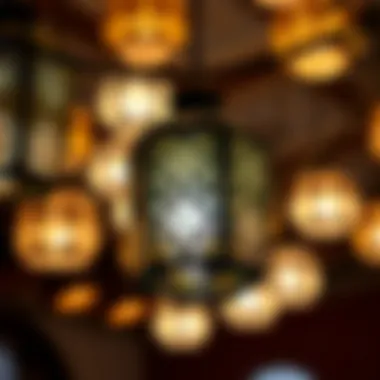

When we think of traditional dishes for Eid, a plethora of tantalizing options come to mind. One might find Harees, a dish made from wheat, meat, and a touch of spice, known for its comforting essence. Another beloved dish is Biryani, where marinated meat meets fragrant rice, stewed to perfection. The plethora of spices reflects the UAE's cultural melting pot, arousing a vivid palate that’s hard to forget.
- Machboos, a spiced rice dish usually served with lamb or chicken, is a staple that never fails at gatherings.
- Kebabs and Shawarma are not to be overlooked, providing a delightful twist that complements the traditional dishes well.
Each dish, cooked with care, symbolizes love and respect for the tradition. Families often share recipes that have been in the family for decades, making them unique blends of nostalgia and flavor that define their Eid experience.
Sweets and Desserts
Eid celebrations wouldn’t be complete without indulging in sweets and desserts. After the hearty meals, a selection of something sweet tantalizes the senses. Knafeh, a delectable pastry soaked in syrup, is often the star of the dessert table. There’s Baklava too, with its layers of phyllo pastry, nuts, and honey, offering a crunch that pairs beautifully with Arabic coffee.
Not to be missed is Maamoul, small cookies filled with dates or nuts and often shaped in intricate designs. Each of these treats tells its own story, reflecting the joyous spirit of Eid.
In addition to these delicious creations, families often take the time to distribute sweets to neighbors and friends. This act not only spreads joy but also reinforces bonds within communities, making the festival a harmonious occasion.
Community Feasts
The essence of Eid truly shines through community feasts. Numerous families come together to share meals that highlight the generosity inherent in the holiday. Local mosques and community centers often organize large gatherings, where people from different backgrounds unite to celebrate together.
- These communal meals foster inclusiveness—a chance to meet others, share experiences, and deepen connections within the diverse Emirati society.
- Charity plays a role here too, as many choose to prepare extra food to donate, illustrating the spirit of giving that is central to Eid.
Through communal dining, the act of breaking bread becomes a powerful symbol of unity and understanding.
"Food is not just about what we eat; it's about whom we share it with. During Eid, it becomes a festival of joy we celebrate together."
In summation, the culinary traditions of Eid Al-Fitr beautifully encapsulate the heart of the celebration in the UAE. From traditional dishes to sumptuous desserts and community feasts, food embodies the spirit of togetherness, hospitality, and generosity that marks this significant occasion.
Social and Community Engagement
One of the cornerstones of Eid Al-Fitr celebrations in the UAE is the rich tapestry of social and community engagement. This period is not just about festive rituals; it's an opportunity for communities to come together, reinforcing bonds and creating a sense of belonging. This is especially pertinent in a multicultural society such as the UAE, where residents hail from various backgrounds. The ways in which this social dimension unfolds during Eid provide valuable insights into the collective spirit of the nation.
Acts of Charity
Eid Al-Fitr is deeply intertwined with the act of giving, which is encapsulated in the concept of Zakat al-Fitr. Before the Eid prayer, it is customary for Muslims to contribute a small amount of food or money to assist those in need. This practice not only helps the less fortunate but also serves as a reminder of the importance of gratitude and compassion.
"Charity does not decrease wealth." - A common saying that resonates with the essence of Eid.
Local organizations often organize charity drives and campaigns during this period, enhancing community interaction. For instance, this year's charitable initiatives in Dubai included distributing food packets to migrant workers and underprivileged families, reinforcing the idea that Eid is about lifting spirits and alleviating hardships.
Family Gatherings
Family gatherings during Eid go beyond simply sharing meals. It's a time when relatives, whether they live nearby or overseas, make a concerted effort to connect. The practices may vary from hosting large family meals featuring traditional dishes to exchanging gifts that reflect personal sentiments rather than material value.
While the joyful laughter and the sharing of heartfelt stories takes center stage, it’s also a moment for family members to reflect on the year gone by, celebrate its successes, and support one another through challenges. The intensity of these familial bonds during Eid creates a fabric of support that is traditionally very important in the UAE's society.
Cultural Programs
Festivals and cultural programs are another vital layer of community engagement during Eid. This year, various events were held across key emirates to promote arts, culture, and heritage.
- Live performances: Many local artists took the stage, showcasing vernacular music and dances that spark feelings of nostalgia.
- Art exhibitions: These highlighted the richness of Emirati culture, often featuring contributions from diverse expatriate communities, enriching the celebration with a multicultural flair.
- Workshops and activities: Programs for children and families encouraged participation in traditional crafts and storytelling, fostering knowledge and appreciation for different cultural narratives.
Ultimately, these cultural programs create a platform for shared experiences that bridge generational gaps. They not only pay homage to the past but also shape a collective identity that is inclusive and forward-thinking.
In summary, the social and community engagement seen during Eid Al-Fitr is fundamental to weaving the fabric of mutual respect and understanding within the UAE. The values of charity, family unity, and cultural celebration serve as the guiding principles that enrich this festive occasion.
Eid Al-Fitr Celebrations in Dubai
Eid Al-Fitr in Dubai is a grand spectacle, showcasing the city's unique blend of tradition and modernity. This momentous occasion marks the end of Ramadan, bringing together families, friends, and even communities in a heartfelt celebration. The festivities in this bustling metropolis are not just about religious obligations; they are intertwined with social, cultural, and economic aspects that resonate deeply with residents and visitors alike.
Public Festivities
One of the most striking features of Eid Al-Fitr in Dubai is the abundance of public festivities. Parks, malls, and communal spaces transform into vibrant hubs of activity. Families flock to places like Al Seef, where cultural shows are often held. These events are carefully crafted to reflect the emirate's rich cultural tapestry. From traditional music to folk dances, the public festivities offer a taste of heritage that resonates with both Emiratis and expatriates.
Moreover, there's typically a family-oriented atmosphere that envelops the public celebrations. It's not uncommon to see parents guiding their children through various activities, such as arts and crafts or community games. This approach fosters a sense of belonging and community spirit during the holidays.
Fireworks and Parades
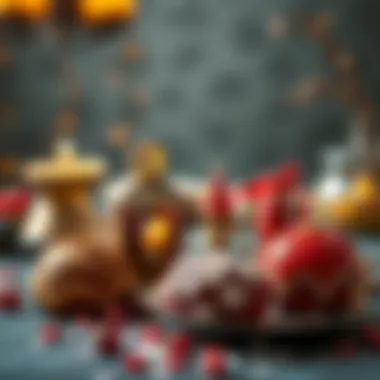

When it comes to fireworks and parades, Dubai doesn't hold back. The skies light up with dazzling displays, often accompanied by synchronized music. Locations like the Burj Khalifa and Dubai Creek become focal points for these nighttime spectacles. Crowds gather, cameras ready, to capture the fleeting beauty of each burst of color against the night sky.
Parades also play a pivotal role in the celebrations. The streets come alive with floats that showcase themes of unity and joy. Local organizations and schools often participate, allowing for a fantastic showcase of talent and creativity.
"The grandeur of Eid fireworks in Dubai symbolizes the city's commitment to celebrating diversity and fostering togetherness."
Shopping Trends
Eid Al-Fitr significantly influences shopping trends in Dubai. Retailers prepare months in advance, anticipating a surge in sales. The festive spirit promotes not just traditional clothing, but also luxurious gifts and gourmet food items. Malls like The Dubai Mall and Mall of the Emirates become bustling marketplaces filled with customers seeking the perfect outfit for the Eid prayers or a special gift for loved ones.
Discounts and special offers abound during this period, enticing shoppers searching for the best deals. The combination of festive cheer and economic opportunity creates a shopping environment that is exhilarating and sometimes chaotic, but ultimately rewarding for both buyers and sellers. Online shopping trends also see an upward spike, with many opting for convenience in avoiding the bustling crowds.
Impact on the Real Estate Market
The influence of Eid Al-Fitr on the real estate market in the UAE cannot be overstated. As the nation gears up for this major celebration, various economic activities including hospitality, retail, and, notably, real estate see significant boosts. This section delves into the relationship between the festive period and the real estate climate, emphasizing how increased foot traffic, demand for accommodations, and consumer spending patterns can shape property trends. For investors and homeowners alike, understanding these nuances can inform better decisions and provide a clear picture of potential opportunities and challenges.
Increased Demand for Rentals
Eid Al-Fitr often correlates with a spike in rental demand across the UAE, particularly in urban areas like Dubai and Abu Dhabi. Many families from overseas travel to the UAE to join their relatives during this festive period. This influx naturally increases the need for short-term housing solutions.
- Vacancy rates dive during the festive season as families aim to gather together, adding pressure to the already competitive rental markets.
- Rental platforms like Airbnb see notable activity, with hosts raising prices due to the heightened demand. This quick surge in rental prices can impact both residents and investors.
Research indicates that rental properties in proximity to community centers and places of worship attract more interest during Eid, as families look to stay near the heart of celebrations. Therefore, landlords who can adapt swiftly to changing demands often enjoy better returns on their properties.
Luxury Property Market Trends
The luxury property sector also feels the ripple effects of Eid celebrations. High-net-worth individuals often seize this festive time to invest in opulent real estate, perhaps to accommodate visiting family or simply to enjoy their lifestyle during holidays.
- Properties that come equipped with amenities tailored for entertaining—such as lavish pools, outdoor kitchens, and spacious living areas—tend to attract greater attention.
- The development of high-end areas like Dubai Marina and Palm Jumeirah showcases the trend of luxury living being intertwined with festive celebrations.
Another angle to consider is the market's evolution post-pandemic. The renewed interest in vacation homes and luxury rentals signals that even affluent buyers are now pursuing opportunities that complement their lifestyle aspirations. As a result, we may witness a shift in buyer behavior, prioritizing properties that accommodate rich lifestyle experiences during Eid.
Commercial Real Estate Insights
Eid Al-Fitr is a boon for commercial real estate as well. The festive spirit drives increased consumer expenditure in retail sectors. Consequently, businesses ramp up their operations and needs for retail space.
- Pop-up stores and themed markets often appear during Eid, seeking temporary leases. This offers investors insight into the potential for short-term rental strategies tailored to a bustling market.
- Retailers adjust their inventory and sales strategies to align with festive shopping, positively impacting shopping malls and high-street properties that manage to adapt quickly.
Moreover, office spaces are seeing early signs of post-pandemic recovery, as businesses attempt to return to a semblance of normalcy with more employees coming back for operations amid the celebration. The festive season showcases an uptick in commercial activities such as collaborations and community events, paving the way for heightened opportunities in this segment.
"Understanding the seasonal impact of Eid on the real estate market can provide invaluable insights for investors who wish to capitalize on evolving trends."
In summary, the interplay between Eid Al-Fitr and the real estate industry in the UAE illustrates how cultural celebrations can act as catalysts for market dynamics. The increased demand for rentals, the sophistication of the luxury market, and the vibrancy of commercial real estate during this period reflect the broader insights needed for both present-day and future investment strategies.
The Role of Technology in Celebrations
In an ever-evolving world, technology plays a pivotal role in how communities celebrate significant occasions, including Eid Al-Fitr. 2023 in the UAE showcases this dynamic shift towards digital enablers that facilitate not just the planning but also the experience of Eid festivities. The benefits of technology are manifold, ranging from enabling virtual connections to streamlining transactions. This section examines some core aspects, benefits, and considerations surrounding the role technology plays in contemporary Eid celebrations.
Virtual Gatherings
With the advent of digital communication platforms, virtual gatherings have become the lifeline for many during festive periods. As families often spread across various locales, celebrating together in person can be togh sometimes. During Eid Al-Fitr in 2023, video calling applications like Zoom or WhatsApp have made it a breeze for families and friends to connect.
Notably, many individuals have adopted these platforms to host online iftars, allowing for shared meals and moments of reflection. This digital format bridges distances that typically separate loved ones, bringing a sense of closeness despite physical separation.
- Benefits of virtual gatherings include:
- Bridging distance gaps
- Facilitating inclusivity for those unable to attend in person
- Offering flexibility in scheduling celebrations
However, it's crucial to maintain a balance between virtual and physical interactions, as the essence of Eid often lies in face-to-face connections.
Mobile Applications and Eid
Mobile applications have revolutionized how people engage with Eid traditions, enhancing convenience and accessibility. From fashion to food, various applications cater to the specific needs and desires of the community.
Applications like Talabat and Zomato often see a spike in usage as families order traditional meals rather than cooking. Moreover, platforms such as Na-dha facilitate donations for charity, ensuring that Zakat is given easily during this festive period. With a mere tap of a button, users can connect with local businesses, making it simpler to engage with traditional elements and support community members.
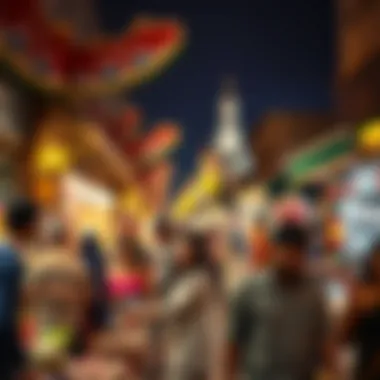

The integration of modern payment systems simplifies shopping, turning the hustle and bustle of Eid shopping into a seamless experience. Users can benefit from:
- Convenience in finding local stores and traditional items
- Support for community-based businesses
- Easier charitable donations
As vibrant as these trends are, some challenges may arise, such as privacy concerns regarding personal information shared on apps.
Online Shopping Trends
Eid Al-Fitr is synonymous with shopping. In 2023, online shopping has gained significant traction, painting an entirely new picture of how individuals prepare for the celebrations. With the convenience of e-commerce websites like noon.com and Amazon, shoppers can browse an array of garments, gifts, and decorations from the comfort of their homes.
The ease of shopping online allows for better comparison, leading to more informed purchasing decisions. Additionally, the rise of social media marketing means businesses are reaching potential customers directly through platforms like Instagram and TikTok. As a result, trends can change rapidly, creating a sense of urgency among shoppers.
Key trends include:
- Increased market demand for traditional attire shown through online ads
- Promotions and discounts encouraging electronic purchases
- Shift towards sustainable fashion choices
The integration of technology into shopping behaviors is firm. It will undoubtedly evolve, making future Eid celebrations both a blend of tradition and modern flair.
The use of technology during Eid Al-Fitr not only reflects the current digital age but also embodies the innovative spirit of communities adapting to new realities.
In wrapping up, technology has transformed Eid Al-Fitr celebrations in the UAE, offering a refreshing blend of tradition and modern conveniences. As these tools continue to evolve, they can forge new paths for connection, community engagement, and the overall experience of this significant holiday.
Contemporary Adaptations
The landscape of Eid Al-Fitr celebrations in the UAE has witnessed significant transformations over the years. These changes, often termed contemporary adaptations, are not just trends but reflect a broader narrative of cultural evolution and progress. They intertwine tradition with modernity, resulting in an Eid celebration that is both familiar and fresh. This section aims to explore the elements, benefits, and important considerations surrounding these adaptations.
Evolving Customs
Traditions that once defined Eid celebrations are morphing. In many households, the shift has been noticeable, particularly regarding gift-giving and communal gatherings. For instance, while gifts used to comprise intricate traditional items such as clothing and sweets, many now opt for experiences, like travel vouchers or entertainment passes. This shift points to a growing emphasis on shared experiences over physical possessions.
Moreover, community gatherings are increasingly inclusive, welcoming individuals from diverse backgrounds. This blending points towards an evolving culture. One example is the rise of community Iftars, where families from different cultural backgrounds come together for meals, sharing diverse culinary practices while reinforcing social ties. There's a sense of warmth and togetherness that transcends mere ritual; it speaks to a collective spirit of unity.
Influence of Expat Communities
The UAE hosts a tapestry of expat communities whose presence significantly shapes contemporary Eid celebrations. For these groups, often far from their homelands, Eid is a chance to maintain connections to their original cultures while simultaneously integrating into the local community. In cities like Dubai and Abu Dhabi, one can see a fusion of customs, with expats celebrating their unique traditions alongside local practices.
Expats have played a vital role in introducing new flavors, styles, and forms of celebration that enrich Eid. Take, for instance, the introduction of diverse cuisines from South Asia, the Middle East, and Africa during festive gatherings. Such culinary integration not only highlights the diversity of the UAE but also fosters an understanding and appreciation for various cultural practices. Expat communities encourage the spirit of Eid as a time for inclusivity, aiding in building bridges between cultures in a celebratory manner.
Globalization Effects
As globalization becomes more pronounced, the impacts on Eid celebrations are increasingly evident. The rise of social media and online platforms exposed local communities to a broader range of customs and practices from around the globe. In 2023, one's timeline may showcase varied Eid greetings, from digital cards to live-streamed prayer services, reflecting a blending of both traditional and contemporary approaches.
Moreover, globalization also allows for the sharing of ideas that mold celebrations. For example, in recent years, a growing trend toward sustainability has influenced how public events and personal celebrations are conducted. Eco-friendly initiatives, such as minimizing waste during feasts or promoting sustainable gifting practices, have emerged. This alignment with global movements, like climate awareness, signifies how Eid celebrations are not solely anchored in heritage; they are adapting responsively to contemporary global challenges, enhancing the significance of the festivities.
"The way we celebrate Eid tells a story not just of tradition, but also of who we are now as a community, encompassing our diverse identities and shared values."
In summary, contemporary adaptations of Eid Al-Fitr reflect a lively interplay between tradition, community influences, and global trends. Acknowledging the significance of these changes offers insights into a society that is continually evolving, yet remains rooted in its rich heritage.
Looking Ahead: Future of Eid Celebrations
Eid Al-Fitr, marked by its vibrant festivities and rich traditions, holds a prominent place in the cultural tapestry of the UAE. As the dynamics shift in global society, the future of these celebrations beckons a reexamination. The traditions of Eid must evolve to resonate with younger generations while still preserving valuable customs. This section explores the pivotal elements influencing the future of Eid celebrations, including predictions, sustainability practices, and the community's vision.
Predictions for Subsequent Years
Looking into the crystal ball, several factors could shape Eid celebrations in the years to come. Demographic shifts, technological advancements, and evolving social norms play significant roles. For instance, the influx of expatriates continues to diversify the community in the UAE. This growing multicultural environment may lead to hybrid celebrations that combine various cultural influences, thereby enriching the Eid experience.
Moreover, there's a distinct possibility that the economic environment will steer how festivities are celebrated. With many families facing financial constraints, more modest celebrations might become prevalent. Community potlucks and group gatherings could replace lavish personal feasts, fostering togetherness without breaking the bank. As people become increasingly savvy about economic trends, they may seek a greater balance between festivity and fiscal responsibility.
Sustainability in Eid Practices
Sustainability emerges as a crucial consideration for the future of Eid celebrations. As the world grapples with environmental concerns, incorporating eco-conscious practices into Eid celebrations is gaining traction. Families might choose to use biodegradable decorations or limit single-use items during their gatherings, promoting a greener narrative.
Engagement with local farms for fresh produce can also reshape culinary traditions, aligning the festivities with sustainable practices. Joint community initiatives like tree-planting during Eid could strengthen the connection between the joyous spirit of the holiday and the responsibility we hold towards our planet. For organizations, going green could enhance their reputation and values, appealing to socially aware consumers. The conversation around sustainability is taking root, shaping a future where enjoyment and environmental stewardship can coexist.
Community Vision
As we navigate the future, the vision of the community holds immense power. Residents, local leaders, and even government bodies play a vital role in shaping how Eid will be celebrated. There is a growing emphasis on inclusivity, outreach, and participation. Engaging the younger generation in planning and orchestrating celebratory events can foster a spirit of belonging that transcends cultural barriers.
Moreover, the use of social media platforms allows for the sharing of diverse experiences and real-time celebrations, creating a global village of Eid observers. The community's vision for Eid in the future is one that embraces diversity, advocates for sustainability, and maintains the core values of compassion, charity, and joy.
"Tradition tells us where we come from; innovation shows us where we are heading."



